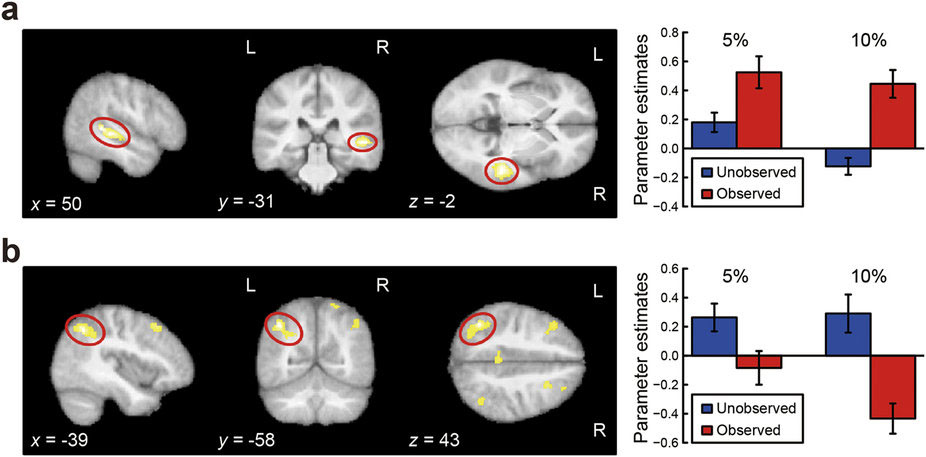Research Abstract
他人に見られるとあがるのはなぜ?:観衆の存在は下頭頂皮質を介して運動パフォーマンスに影響する
Why I tense up when you watch me: Inferior parietal cortex mediates an audience’s influence on motor performance
2016年1月20日 Scientific Reports 6 : 19305 doi: 10.1038/srep19305

自分を評価する観衆がいると、力の出方が変わってしまい、慣れているはずの運動技能でも思うようにできないことがある。このとき脳の中で何が起きているかを調べるため、機能的磁気共鳴画像の撮像中、リアルタイムに他者から見られている状況下で、実験参加者に微妙な握力調節課題を行ってもらった。その結果、他者から評価される条件では、発揮力が増加するとともに、両側の下頭頂皮質が局所的な活動低下を示した。さらに、左側下頭頂皮質の活動低下の度合いによって、他者からの評価による握力変化の個人間及び個人内の違いを予測することができた。また、他者から評価される条件下では、他者の行為に関する視覚的情報を下頭頂皮質に伝える後部上側頭溝の活動が高まった。興味深いことに、これら2領域間の機能的結合は、他者から評価される条件下で弱まっていた。下頭頂皮質は、対象物の操作に必要な感覚運動統合に関係するとともに、観察された行為の遂行を助ける「行為観察ネットワーク」の一部だと考えられている。このような下頭頂皮質の活動変化が、他者からの評価による力発揮の変化を媒介することを、我々のデータは示唆している。他者から評価される状況では、自己の意図した行為と他者の意図の認知との間に、高次表象の不一致が生じることで、感覚運動変換の脳内ダイナミクスが分断され、最終的に運動出力が攪乱されるのかもしれない。
Michiko Yoshie, Yoko Nagai, Hugo D. Critchley & Neil A. Harrison
Corresponding Author
The presence of an evaluative audience can alter skilled motor performance through changes in force output. To investigate how this is mediated within the brain, we emulated real-time social monitoring of participants’ performance of a fine grip task during functional magnetic resonance neuroimaging. We observed an increase in force output during social evaluation that was accompanied by focal reductions in activity within bilateral inferior parietal cortex. Moreover, deactivation of the left inferior parietal cortex predicted both inter- and intra-individual differences in socially-induced change in grip force. Social evaluation also enhanced activation within the posterior superior temporal sulcus, which conveys visual information about others’ actions to the inferior parietal cortex. Interestingly, functional connectivity between these two regions was attenuated by social evaluation. Our data suggest that social evaluation can vary force output through the altered engagement of inferior parietal cortex; a region implicated in sensorimotor integration necessary for object manipulation, and a component of the action-observation network which integrates and facilitates performance of observed actions. Social-evaluative situations may induce high-level representational incoherence between one’s own intentioned action and the perceived intention of others which, by uncoupling the dynamics of sensorimotor facilitation, could ultimately perturbe motor output.

